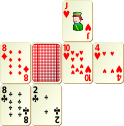
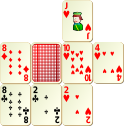
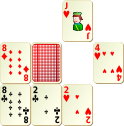
An original card game by Daniel Schulman. It's freely available for any use, as long as you give credit. Look here for more games!
Jericho is probably my favorite of my games when I want one that requires some thought and careful play. The rules are simple, but are a little different from most card games, so can be tricky at first.
The basic idea of the game is to place cards so that adjacent cards match suit or rank. If you surround a card on all 4 sides, you remove it and earn points. However, there's a few small twists that make things much more interesting.
2 players, and a standard 52-card deck. You'll need a decent amount of clear space to play on — a foot and a half square should do. Choose a dealer in any way you like. With a shuffled deck, deal out 5 cards to each player.
Take the top card (without looking at it), and place it face-down in the center of the play area. This card is the base. Place the rest of the cards off to one side, to make the draw pile.
You'll also want to leave space for 3 more piles: a discard pile, a one capture pile for each player. Unlike most card games, you can inspect the contents of the discard pile and the capture piles whenever you want.

Start by placing any card from your hand face up, adjacent (horizontally or vertically) to at least one other card. You must match suit or rank to all adjacent cards. Any card can be placed next to the base.
For example, you can place any card at all on the spot labeled 1, since the only adjacent card is the base (cards that touch diagonally don't matter, so it doesn't need to match the 10 of Hearts). On 2, you could place any 10 or any Heart. On 3, there are two adjacent cards, so you could only place the 10 of Clubs, or the 2 of Hearts.

|

|

|
If you surround a card on all 4 sides when you place something down, that card is captured, and moved to your capture pile. You collect points equal to the rank of the card; Aces are worth 1 point, and face cards are all worth 10.
It is possible to capture two or (very rarely) more cards at a time. Remove all the captured cards, and collect points for all of them.
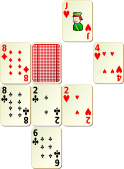
|
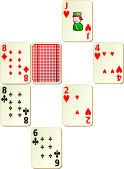
|
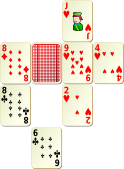
|

|
If you capture any cards, you may continue by placing another card down, but only if you can capture something else by doing so. Your turn can keep going until either there are no cards left in your hand, or you cannot capture anything else.
You are allowed to place a card so that it is already surrounded. In the example above, the 9 of Hearts is placed in the center of 4 cards, and immediately captured.

|

|
At the end of your turn, discard all cards on the play area that are not connected to the base. A card is connected if it can be reached from the base by following cards horizontally and vertically. Cards that only touch the base diagonally are not connected.
Finally, refill your hand by taking card from the draw pile until you have a full hand of 5 cards again.
Players alternate turns like this. Eventually the draw pile will run out; if there aren't enough cards left in the draw pile to refill your hand at the end of a turn, just take what there is. This means that you might have less than 5 cards in your hand at the start of a turn, but besides that, play your turn as above.
If you can't, or don't want to, play a card at the start of your turn, you can pass, and skip that turn. You can pass at any point during the game — even if you have cards to play. If you have no cards at all in your hand, then obviously all you can do is pass.
The game is over as soon as both players pass consecutively. Each player gets points for every card in their capture pile: Aces are 1, face cards are 10, and all others are worth their rank. The player with the most points wins.
It's obviously risky to place something on the third side of a card and give your opponent the chance to capture it. This won't get you very far, though; you end up either placing purely defensively, or taking unnecessary chances and giving cards to your opponent.
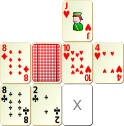
The strategy of Jericho revolves around blocks. To make a block, you place cards of two different ranks adjacent to an empty space on the play area. Above, the space marked X is a block.
The purpose of a block is to make it difficult for your opponent to play a card in a particular spot. There are only two cards in the deck that could fill that spot (the 10 of Clubs, and the 2 of Diamonds), so the odds are good that your opponent will not have one of them in their hand. There are two main uses of blocks. First, you can use it to stop your opponent from capturing a card. Second, and more interestingly, if you have one of the 2 cards that can fill the block, you can surround a card with only a small chance of your opponent capturing it.
Some blocks are stronger than others, depending on what cards are remaining in the deck. A block where both cards are still in the deck is a weak block. When only one card is left, it's a strong block, and when there are none, it's a total block. This is where it becomes really useful to be able to inspect the discard and capture piles.
Blocks tend to get stronger towards the end of the game, when there aren't many cards left. It can be worthwhile to make some moves that would be risky earlier.

The graphics make use of the excellent public domain clip art available from the Open Clip Art Library, particularly the playing card sets by Nicu Buculei.